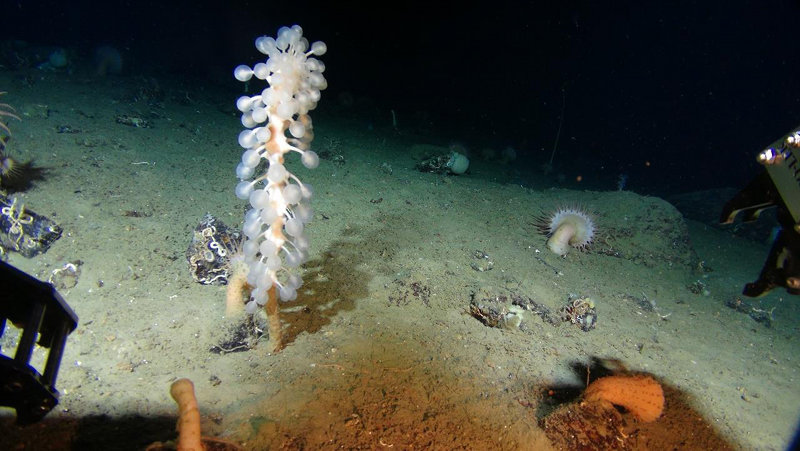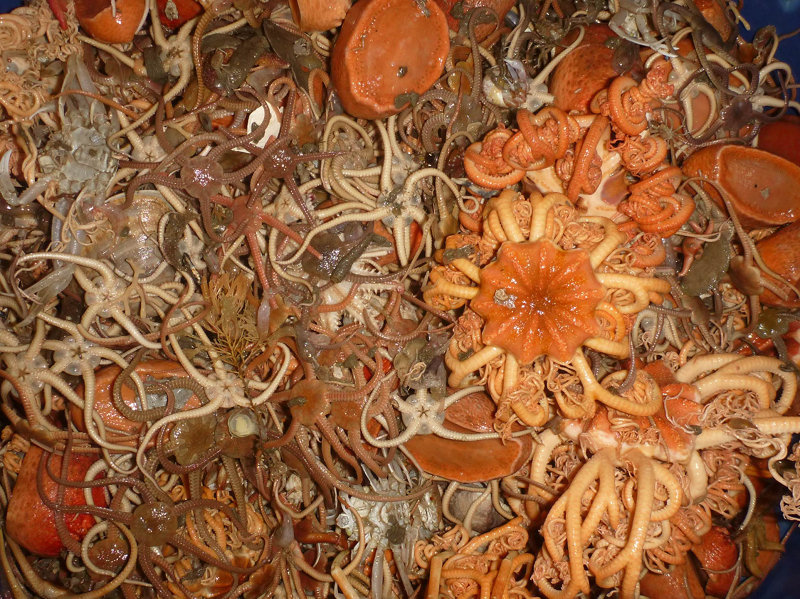
By Katrin Iken, University of Alaska Fairbanks
Benthic – or seafloor - organisms are the element that have garnered probably among the most scientific interest and curiosity about seamounts. The typically hard substrate of the seamount tops support a unique and highly diverse fauna. Some of the most conspicuous species on these seamounts are corals. While most people think of colorful tropical coral reefs teeming with life along sunny beaches, corals on seamounts in deep waters are a different kind of corals, but they are no less fascinating and ecologically important. Rich assemblages of deep-sea corals and other organisms such as sponges create a diverse and structurally complex habitat that is often home to many associated other organisms from worms and snails to fishes. Within a deep-sea basin, these seamount organisms are unique to the tops and upper slopes of seamounts and do not occur on the soft sediments of the surrounding deep waters.

The carnivorous sponge Chondrocladia grandis off Baffin Island, Canada. Note the inflated spheres and how its main body protrudes into the sediment. Image courtesy of ArcticNet. From the Northern Neighbors - Transboundary Exploration of Deepwater Communities Expedition. Download image (jpg, 1.9 MB).
Only a handful of studies have investigated the fauna of some of the Gulf of Alaska seamounts to date. Most about the known seamount fauna relates to some fish species, especially sablefish, also known as black cod on the seafood market, which is a managed fishery species in Alaska. Other common fish species on Gulf of Alaska seamounts include ecologically important species such as grenadiers, thornyheads, Pacific flatnose, and rockfishes. Early investigations on Gulf of Alaska seamounts also recorded commercially important king and Tanner crab species. Other conspicuous invertebrate fauna were feather stars, brittle stars, sea cucumbers, squat lobsters, and most of all, corals and sponges. About 20 deepwater coral species have been recorded in Gulf of Alaska deep waters so far, including on seamounts. The Gulf of Alaska seamount corals seem unique among most other North Pacific seamounts in their low abundance of hard (scleractinian) corals and higher abundance of soft corals. While these earlier investigations provide some understanding of Alaska seamount fauna, there is a great need to better identify and describe the seamount communities and the associations with specific biological or geological habitat features.

A trawl catch of the rich benthic fauna on the Arctic shelf at 50 meters (164 feet) depth showing lots of brittle stars, feather stars, and sea cucumbers. Image courtesy of Katrin Iken, University of Alaska Fairbanks: From the Hidden Ocean - The Chukchi Borderlands 2016 Expedition. Download larger version (jpg, 421 KB).
Seamounts in the Gulf of Alaska are prohibited from bottom contact fishing to protect these unique environments and sensitive faunas. Therefore, advanced technology such as a remotely operated vehicle (ROV) with high-resolution cameras and minimally invasive sampling tools can sample the underexplored seamount benthic fauna in a least-invasive way. Using this sampling approach alleviates concerns regarding trawling in a system dominated by structural, long-lived habitat builders such as the corals and sponges. We are excited to use the ROV Global Explorer in the deep basin and seamounts of the Gulf of Alaska to investigate diversity, species associations, and fine-scale distribution of benthic taxa along topographic habitat features such as on the seamounts.